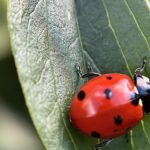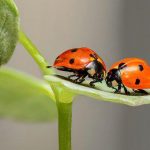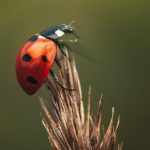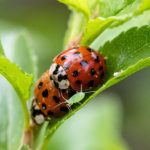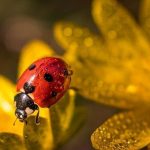Yes, ladybugs devour spider mites as well as a variety of other minor pests. Ladybugs can be useful in pest management since they are voracious feeders and do not harm plants. If you don’t already have ladybugs in your garden, you have two possibilities.
You may either purchase ladybugs from a specialist store and release them into your garden, or you can attract ladybugs from the nearby neighborhood.

If you already have spider mites in your yard, attracting ladybugs shouldn’t be too tough. Ladybugs, like other creatures, will seek food. When there aren’t enough pests to eat, ladybugs will devour pollen and flower nectar. Ladybugs will come to your garden if you put some of their favorite plants, such as dill, cilantro, cosmos, and tansy.

Can ladybugs be used to spider mites?
Ladybugs, along with numerous other kinds of microscopic pests, do, in fact, consume spider mites. Since ladybugs are such voracious eaters and don’t cause any harm to the plants they feed on, they may be an invaluable tool for pest management. There are two routes you may take if you do not currently have ladybugs living in your yard.
Does anything eat spider mites?
Important predators include predatory mites, which are roughly the same size as plant-feeding mites but have longer legs and are more active. Plant-feeding mites feed on plant material. Thrips, lacewings, and minute pirate bugs are examples of some of the other prevalent natural enemies.
What is the best predator for spider mites?
The principal predator of spider mites is the species known as Persimilis, which is also the only one that will enter the web and feed on the mites there. They thrive in an area with a humidity of at least 60 percent, but you can also assist them by spraying their plants twice a day to keep the surrounding environment humid (pest spider mites love dry conditions). If you are dealing with a significant infestation or the conditions are less than ideal, it is possible that you may need to reintroduce them after seven to ten days.

How many spider mites do ladybugs eat a day?
Adult ladybugs may survive for more than a year and can consume up to nine mites every hour, which is the equivalent of 75 to 100 mites every day.
When compared to the predatory mite, the lady bug is quite a bit larger. The color is often a creamy white, and it has the form of a pear. Young mites mature into adult mites in a relatively short amount of time, and because of their ravenous appetites, they are a powerful foe for spider mites. Adults may consume up to 350 mites during the course of their existence, which is around 75 days.

Will ladybugs eat spider mite eggs?
Ladybugs, along with numerous other kinds of microscopic pests, do, in fact, consume spider mites. Since ladybugs are such voracious eaters and don’t cause any harm to the plants they feed on, they may be an invaluable tool for pest management. There are two routes you may take if you do not currently have ladybugs living in your yard.
What bug kills spider mites?
The ladybug known as Stethorus punctum and the predatory mite known as T. pyri are the two types of insect specialists that are most commonly utilized to manage spider mite populations. These insects serve as predators for two distinct species of spider mites, namely the European red mites and the two-spotted spider mites, both of which are considered to be agricultural pests around the globe.

Which spiders are ladybugs likely to eat?
Several factors influence which spider ladybugs will consume. This covers the type of ladybug, its habitat, and other food sources. Because they are little, they will not be able to compete with any giant spider species.
While many people mix all ladybugs together, over 5,000 distinct species have been recognized. They all have different behaviors depending on where they live. Spider mites might be a nuisance in many areas, but they also provide nutritious food for ladybugs! Spider mites wreak havoc on plants and trees. There is some disagreement over whether or not they are spiders.
They are connected, which is why they might be confused with this sort of information. Ladybugs can help prevent spider mites from harming or destroying plants and trees.
Ladybugs will not put themselves in danger. They are not interested in huge or deadly spiders. They will only be able to ingest soft-bodied creatures. They are seeking for a simple target, something they can rapidly get and consume without putting their health at danger.

What kinds of insects do ladybugs prefer to eat?
You are undoubtedly already aware of the fact that almost all species of ladybugs are carnivores in both their adult and larval stages. They feed on a wide variety of prey, such as aphids, scale, mites, mealy bugs, tiny caterpillars, insect eggs and pupae, whiteflies, mites, and psyllids. Their diet also includes psyllids.

Do ladybugs destroy plants?
Ladybugs, often known as lady beetles or ladybirds, are beneficial insects that feed voraciously on pests in flowerbeds and vegetable gardens without causing any harm to the plants themselves. The larvae of ladybugs are even more voracious eaters than the adults.

On what do ladybugs release their eggs?
On the underside of a leaf, typically in an area where aphids have congregated, ladybugs will deposit their eggs in neat little clusters or rows. After a few days, the larvae, which can range in size, shape, and color depending on the species, emerge.

I’m infested with spider mites. Will ladybugs protect me?
Not in most cases. Since ladybugs are generalist predators, this means that under a wide variety of conditions, they will consume a wide variety of different pests. Although this is true, it does not change the fact that aphids are ladybugs’ primary food source. Therefore, if ladybugs have reason to assume that they can locate aphids elsewhere, they will most likely abandon the spider mite infestation you have. If you do indeed have spider mites, check out this page on our website to learn more about the predatory mites that we recommend using to get rid of spider mites.
How can ladybugs be used to control spider mites and other pests?
You may quickly and effectively combat a spider mite infestation in your garden by releasing ladybugs there. This will help keep the spider mite population in check. You can buy ladybugs that are ready to be released around your cannabis plants at most garden stores and nurseries. If you want to ensure that your population adapts well to their new environment, be sure to follow the suggestions that are listed below:

- Utilize a large number
Despite the fact that a single ladybug is capable of eating a great number of spider mites, you will need to release a large number of them all at once in order to complete the task. The spider mite population grows rapidly, and it’s possible that some of the ladybugs will perish or go away.
- Early morning/evening release
Ladybugs don’t like the heat, therefore the best time to release them is early in the morning or early in the evening. If you let them out during the middle of the day, there is a good probability that they will fly away to find somewhere cooler to rest. If you release them at the appropriate moment, there is a greater probability that they will remain in the area.
- A fine mist should be sprayed over your plants
Put a layer of moisture on top of your plants to make it easier for the creatures that are good to your garden to feel at home and remain.
Do Ladybugs rely on their vision to hunt Spider Mites?
Ladybugs rely on their vision to hunt Spider Mites. Contrary to popular belief, are ladybugs colorblind? No, they can see various colors and use this ability to locate their prey. These bright little insects use their sharp vision to spot Spider Mites, aiding them in their mission to control these pests in gardens and farms.
Do Ladybugs Eat Ants?
The ladybug’s diet examined in this informative article reveals that while ladybugs are known to consume aphids, they aren’t inclined to eat ants. The primary reason is that ants produce a noxious chemical that acts as a deterrent for ladybugs. Instead, ladybugs prefer feasting on plant pests, providing natural pest control in gardens and crops.
Are Ducks a Part of an Alligator’s Diet?
Ducks beware! Have you ever wondered about the alligator’s surprising diet: do they eat ducks?? Well, these reptiles are not picky eaters. Ducks often fall prey to alligators, who stealthily approach them in water bodies. With their strong jaws, alligators grab their feathered meal when it goes for a swim.
What does an infestation of spider mites look like?
In contrast to bigger pests such as squash bugs and June bugs, spider mites themselves are indiscernible to the human eye due to their minute size. If you examine a plant carefully, the most you will be able to see are dots that are bluish-green or reddish in color, despite the fact that they have six legs each. The cover provided by the leaves is where they like to hide the most.
You would need a microscope to see that much detail, but different kinds of spider mites each have their own unique coloration, and some of them even have stripes on them.

Small, dark brown or “burnt” patches on the leaf surface are a telltale sign of the early stages of an infestation caused by spider mites. These spots can be found in the early stages of a spider mite infestation. At this stage, swiping these small charred patches with soft tissue effectively identifies the bug that caused them. If it is mites, you should be able to detect tiny streaks of mite blood if you look closely.
After that, the eggs will show up. These are rather little, spherical in shape, and see-through.
Spider mites spin a web that is thick, extremely thin, and sticky. This web may quickly cover the whole plant and serves to protect the spider mites’ eggs. Your plant will not receive enough amount of sunshine and will not be able to transpire or breathe effectively as a result of this. However, it is not recommended that you wait until the illness has reached this level.


